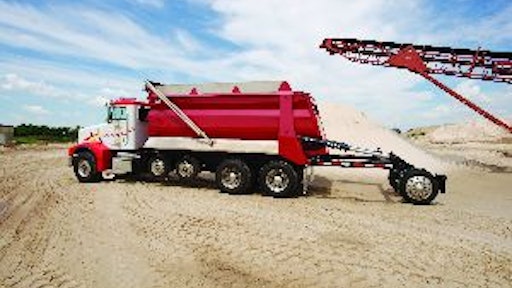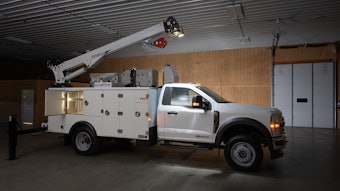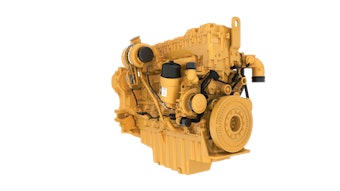
Dump vehicles come in a dizzying array of configurations - standard dump truck, Superdump, transfer dump truck, truck and pup, tractor with end dump trailer, tractor with side dump trailer, tractor with bottom dump trailer, etc. And each of these options can be further customized.
To find the best solution for your applications, you really need to understand the benefits and trade-offs associated with each choice, then match that with your operation and regional regulations.
Standard dump trucks
The short wheelbase of a standard dump truck makes it more maneuverable than tractor/dump trailer combinations. The downside to this configuration is often limited capacity when operated in Bridge Formula states. But there are regions of the country where conventional straight trucks can haul loads competitive with tractor/trailer combinations.
Taylor Services Inc., Blairsville, PA, is a dump truck operation using both four-axle dump trucks with tridem rear axles and tractor/end dump combinations. "We operate about 75 units," says Jeff Taylor. "We are probably two-thirds straight truck and one-third tractor and trailer." This is primarily due to the local regulations in Pennsylvania, and the fact that the company performs most of its work inside the state.
"We are able to haul 73,280 lbs. on a four-axle unit," says Taylor. The trucks are equipped with Trail King square boxes. "We dump as many as 23 loads a day, so we are testing the dump portion pretty strongly."
Maneuverability is important in the company's operations. "Because we are dealing with mine sites and construction sites where space is sometimes limited, the straight truck just gets you in tighter spots," Taylor states.
Taylor Services Inc. also runs 39-ft. end dump trailers, but claims the straight trucks are a safer alternative. "From a dumping standpoint, it is much more stable than a tractor/trailer. Basically, you are putting 20 ft. in the air, rather than 40 ft."
In Pennsylvania, the difference in allowable capacity between straight trucks and end dumps is negligible. "Our tractors and trailers with the 39-ft. frameless end dumps can net about 48,000 lbs.," Taylor asserts. "With our tri-axles, we are netting 47,000 lbs. So the legal payload capacity is about the same."
One of the advantages of tandem and tridem configurations is less complexity compared to pusher and tag axles. "Anytime you add more axles, more tires, more parts, not only does the initial cost go up, the cost to maintain and operate has to go up, as well," says Taylor.
Tractor/trailer combinations
For many states with bridge laws, a day cab tractor pulling a dump trailer will allow maximum payloads. One of the most common is the end dump. The key advantage to the end dump trailer is rapid unloading.
Taylor Services Inc. has quite a few Trail King end dump trailers, primarily for its interstate jobs. "We get into Maryland, West Virginia, Virginia and Ohio - our surrounding states," says Taylor. "The 39-ft. end dump trailer gets us long enough to comply with the Federal Bridge Formula."
Due to the stability issues with end dump trailers when unloading, you don't want just anybody behind the wheel. Taylor stresses it takes a little more training. "You need a little more conscientious individual, no question," he states.
But Taylor believes the benefits of the end dump outweigh the downsides. "The paving equipment - all of the equipment that we do road work with in this area - is set up for end dumps," he explains. "All of the power plants, all of the mines, the bins are set up for end dumps."
Side dump trailers are an attractive alternative for many regions of the country. "Because the tub dumps to the side, there are no restrictions on trailer frame length or axle location," says Rick Lawrence, national sales manager, SmithCo Mfg. "The maximum weight allowed in any state can be achieved, which means better payloads. You can pull doubles and not have to unhook."
Side dumps are also compatible with a wide range of materials. "Because the tub is a totally welded structure with no tailgate or bottom gate, there is no chance of aggregates leaking out," Lawrence points out. "This also allows safe handling of wet types of payloads."
Prairie State Trucking, Sioux Falls, SD, primarily hauls sand and gravel throughout the eastern part of the state. It has 15 dump vehicles, including regular dump trucks, belly dumps and side dumps.
The bulk of the fleet consists of tractors pulling a pair of SmithCo side dump trailers. "My side dump trains are running right around 150,000 lbs.," says Darby Parsons. "We use them just because we can haul so much more tonnage and they are fast. You can dump on the fly with them."
Parsons touts the versatility of the side dump trailers. "You can haul anything with them," he says. "It really ups your chances of getting back hauls. You can dump in a windrow like a belly dump."
Another advantage is they allow Prairie State Trucking to haul landscape boulders for local contractors. "You can tilt a side dump and lay boulders in them," says Parsons. "With the regular dump truck, you have to drop the boulders in them from 5 ft. above."
Prairie State Trucking has tried aluminum end dump trailers in the past. "You need fairly smooth terrain," says Parsons. "[With the side dumps], you don't have to worry about driver experience as much, and it is a lot easier when you are pulling trains. You don't have to worry about getting it jackknifed just right so you can get your load off."
While the company does use belly dumps, the materials that can be hauled are more limited. "They are not as versatile," says Parsons. "You are pretty much limited to hauling sand or gravel or something that will come out of the bottom. Then it contacts your axles. You are always getting material into your brakes and your brake chambers."
Transfers and pups
A transfer dump consists of a standard dump truck pulling a trailer. When you arrive on the jobsite, you unhitch the trailer, dump the load in the truck, then back up to the trailer for the transfer. The aggregate container on the trailer sits on rails and is pulled inside the main dump box by an electric or hydraulic motor. The truck then dumps this second load. The empty container is returned to the trailer, which is again hitched to the dump truck so it can return for another load.
The advantage to this setup is the ability to essentially haul two 10-yd. loads at one time. You also maintain the maneuverability of a 10-yd. dump truck. The downside is there are a lot of steps, and it takes some time to complete the dump process.
A truck and pup has many similarities to the transfer dump. But unlike the transfer trailer, the pup has its own hydraulic ram and is capable of self unloading. The disadvantage is reduced maneuverability on the jobsite.
Live-bottom trailers on the rise
An emerging trend in the market is the growing popularity of live-
bottom trailers.
"It used to be the live-bottom was extremely heavy and extremely expensive compared to an aluminum dump trailer," says Brad Ohl, Northeast district sales manager, Trail King. "Over the past 15 years, the live bottoms have become a lot more competitive as far as weight and price. There is probably a 10% to 15% difference in price. And in the Northeast, you can get almost as much payload on a live-bottom as you can a dump trailer."
The benefits include the ability to unload without the need to put the body up in the air, and to discharge an even flow of materials. But perhaps the biggest benefit is that it helps prevent asphalt segregation.
"In any aggressive market where they really want to try to meet state [paving] specifications, they are looking for the best way to haul asphalt, as well as products that go into asphalt," Ohl notes. "There is no comparison to the live-bottom anymore."
The even material flow also enables the spreading machine to do a better job. "You have a nice even flow of material from the trailer to the spreading machine," says Ohl. "You don't have 20 or 25 tons dropping down into the machine. So you are not rocking the front end of that spreader."
Superdumps
A Superdump is a four-, five- or six-axle straight dump truck equipped with a trailing axle. For example, Strong Industries manufacturers the Strong Arm, a liftable trailing axle rated as high as 13,000 lbs.
Trailing 11 to 13 ft. behind the rear tandem, the Strong Arm stretches out the outer bridge measurement - the distance between the truck's first and last axles - to allow up to 80,000-lb. GVW and typically 26 tons of payload on a seven-axle dump. So not only does the axle bear a portion of the load, it increases the truck's payload capacity in Bridge Formula states, where gross weight limits are determined by the length of the vehicle, the number of axles and how they are spaced.
R&M Resources, Yukon, OK, is one of the top suppliers of golf course sand in the region. The company previously ran end-dump trailers. But when the trailers reached the construction area, they could only stockpile material in parking lots. The trailers weren't stable or maneuverable enough on the sloping, cramped greens and tees.
R&M Resources found a solution in the form of the Superdump, which could match the legal payload of its frameless end-dump trailers - roughly 26 tons. "We get the payload of a semi-trailer, plus the speed of a straight truck," says Mike Mullet, owner. "We can pick up a couple more loads a day vs. the end dump. We're able to get in where we want to dump, get the product off quickly and go back for more. Plus, we're able to pick up an extra couple of bucks on the contract because we are placing material exactly where the customer wants it."
This creates a competitive advantage. "We're the only guys around capable of getting in and out of tight spots with a 25- or 26-ton payload," says Mullet.
Grace Pacific, Honolulu, HA, is the state's largest paving contractor. It runs a fleet of 41 dump vehicles. "Probably half of them are Superdumps - we run 16 and 18 wheelers," says Lorne Fleming, director of the equipment division. "We are not in the competitive trucking business. We truck for our own uses and our own needs."
But productivity is at the top of Grace Pacific's list. "In most situations, the Superdumps carry more product per mile," says Fleming. "The economies are in driver time, in turn time and in loads. In most cases, unless you have multiple dumps somewhere, they are the low-cost provider."
Grace Pacific previously used transfer trailers before switching to Superdumps. "That is all they used here for years," says Fleming. "If you are pulling a trailer, you have to find a place to drop the trailer, go dump the truck, come back and transfer the trailer. The unload time with a Superdump is probably a minute and a half. You dump one load and you are gone. With a truck and transfer, it is up to 20 minutes."
Because of the productivity increase, Grace Pacific has been converting its fleet. "We had a mix," says Fleming. "But in the four years that I have been here, we have gone almost exclusively to Superdumps."



























